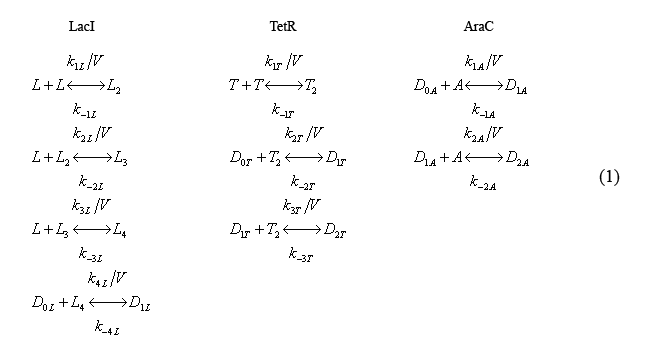Brown:Tri-Stable toggle switch
From 2006.igem.org
(→Fast Reaction Equations) |
(→Fast Reaction Equations) |
||
| Line 7: | Line 7: | ||
====Fast Reaction Equations==== | ====Fast Reaction Equations==== | ||
| - | The following equations describe the fast reactions. The characters L,T,A denote | + | The following equations describe the fast reactions. The characters L,T,A denote molecules of LacI, TetR, and, AraC, respectively while the subscripts denote whether the molecule is a monomer (blank), dimer(sub 2), tri-mer(sub 3), etc. |
[[Image:Fast_rxn_eqs1.png]] | [[Image:Fast_rxn_eqs1.png]] | ||
Revision as of 00:45, 28 October 2006
Modeling of the tristable switch
While the tri-stable switch is seemingly simple in design, just like any other system it is subjected to potentially comprising factors such as promoter leakiness and other stochastic fluctuations. In an attempt to predict the behavior of the tri-stable switch, we created a deterministic model of the system taking into account these factors. The model structure is based on that described in "Prediction and measurement of an autoregulatory genetic module" by Farren Isaacs, et al. This paper features an excellent supplement that takes you hand-in-hand through the derivation of model equations. We will attempt to do the same below. It is important to note that while we hae some preliminary results, our model is very much a work in progress. In order to model the system accurately, many of the fundamental constants governing the model will need to be determined experimentally. For now we have used some constants from the literature and estimated some based on similar the values of similar constants also from the literature.
Derivation of the Model Equations
The chemical reactions describing the tri-stable switch can be divided into the two catagories of fast and slow reactions. Fast reactions such as dimer formation and promoter-binding occur in the scale of seconds and are therefore modeled to be in equilibrium. Conversely, slow reactions including the likes of transcription, translation, and protein degradation occur on the scale of minutes and are thus evolving with time.
Fast Reaction Equations
The following equations describe the fast reactions. The characters L,T,A denote molecules of LacI, TetR, and, AraC, respectively while the subscripts denote whether the molecule is a monomer (blank), dimer(sub 2), tri-mer(sub 3), etc.
link to MATLAB code of model tristable1.m
